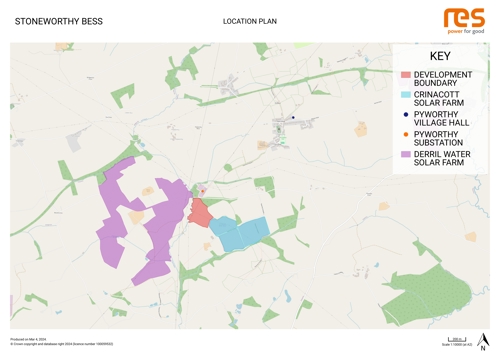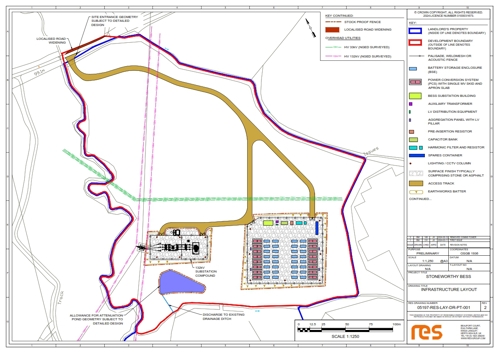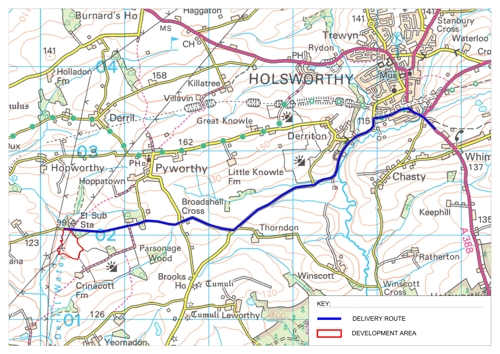Public Consultation Sessions
In March, RES held public consultation sessions in the local area, to enable people to find out more and provide feedback on the proposal.All information provided during at the public consultation sessions is available to view below. Hard copies are available on request, please contact us for more information.
Welcome to our public consultation
Thank you for taking the time to visit our website.
We are seeking your views on the preliminary design for an energy storage proposal that we are exploring on land south of Pyworthy substation, approximately 1.3km southwest of Pyworthy village.
We consider pre-application consultation a crucial part of the energy storage development process and we aim to engage early with the
local community and key stakeholders in order to facilitate constructive consultation. This helps to identify issues and concerns, as well as benefits and opportunities, which we will consider when developing and refining the design and delivery of the proposal. The public consultation sessions form part of our pre-application consultation and is designed to give you the opportunity to:
- learn more about the proposal
- contact us with any questions or views
- provide written feedback to RES on the proposal
A range of information is shared, including details of the site location, design layout, proposed infrastructure, likely delivery route and environmental considerations.
Please take time to read the information provided and contact us about any questions that you may have.
All consultation feedback submitted to RES will be reviewed by the project team over the coming weeks as we continue the design process.
.
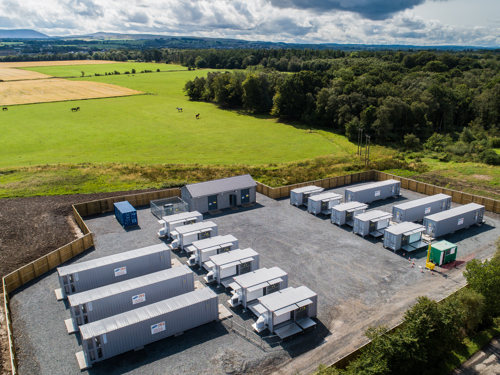
Image for illustrative purposes only
The need for energy storage
Our energy system is in a transitionary period.
Ageing infrastructure is being replaced and greater flexibility introduced into our networks via technological advances, such as energy storage, to manage the increasingly complex supply and demand needs of the 21st Century.
Energy storage is crucial in enabling the rollout of zero carbon energy and supporting the UK’s net-zero emissions target. Renewable energy technologies are needed to replace electricity generation from fossil fuels, however, they can generate electricity intermittently depending on weather conditions, which can cause imbalances in the electricity network.
Energy storage works by storing energy at times when generation exceeds demand and then releases electricity back to the electricity
network when demand exceeds generation.
Energy storage is also considered the fastest technology for responding to a sudden spike in demand or an abrupt loss of supply.
.
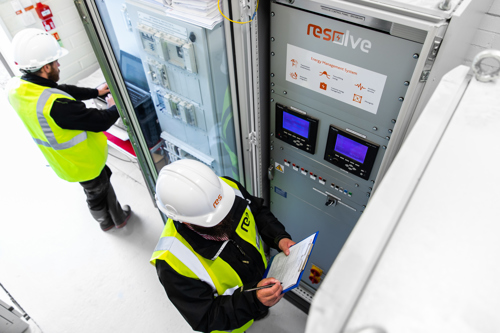
Image for illustrative purposes only
Project overview
The proposed Stoneworthy Energy Storage site is located approximately 1.3km southwest of the village of Pyworthy. The site is currently used for livestock grazing.
An energy storage system needs to be able to both import and export energy and whilst the availability of sites with sufficient import and export capacity is diminishing, the site is in an area with sufficient capacity on the grid network.
The area containing the energy storage system infrastructure is not expected to exceed 5 acres and the site lies outside of any international, national or local environmental designations.
We expect to submit an application for planning consent to Torridge District Council in late Spring 2024.
If consented, the project would connect directly into the 132kV overhead line which crosses the site.
Infrastructure and layout
The plan to the right shows the preliminary layout for the Stoneworthy Energy Storage project.
The proposed system is a containerised scheme, involving proven lithium-ion battery technology which RES has deployed at multiple
projects around the world.
The site would comprise of approximately 32 battery containers which would be one of two types depending on the final choice of supplier – either shipping containers or modular battery containers. Typical dimensions for both types of containers are approximately 6.1 metres long by 2.9 metres high.
The infrastructure would include:
- Battery enclosures
- Power Conversion Systems and Transformers
- DNO Substation
- BESS Substation
- Auxiliary Transformer
- Grid Compliance Equipment
- Grid Connection Infrastructure
- Security System
- Drainage Scheme
- Landscaping
The tallest infrastructure is expected to be the DNO Substation which would have a maximum height of around 4.5 metres.
Environmental considerations
RES will design the energy storage system so that it will fit sensitively in the surrounding landscape.
A number of surveys and assessments will be carried out to ensure any potential impact upon the environment, landscape, heritage and local residents is appropriately assessed and mitigated.
The assessments to be carried out will include:
Ecology
A Preliminary Ecological Appraisal will present the main findings of a desk study and walkover survey, categorising baseline habitats and
conditions and their nature conservation value and predicting any potential ecological impacts from the project.
Noise & vibration
Noise is an important consideration, and the energy storage system is designed to comply with strict noise limits set by the determining
authority should the project be granted consent. The scope of the acoustic assessment includes determining the baseline background
sound levels and predicting sound levels from the project in order to assess the level of potential impact, in accordance with relevant
planning guidance.
Flood risk & surface water management
Detailed design and flood modelling is being undertaken to minimise increased flood risk anywhere on or off site. A Flood Risk and Drainage Impact Assessment will accompany the planning application which will also set out any proposed surface water drainage solution.
.
Landscape
A Landscape and Visual Appraisal considers the site and its surrounding context in both landscape and visual terms, to assess the potential effects of the proposed energy storage system upon landscape features,
landscape character and visual amenity.
Heritage & Archaeology
This assessment sets out the cultural heritage baseline of the site as well as assessing the site’s archaeological potential. It will assess the potential effects of the project on the cultural heritage resource, within the context of relevant legislation and planning policy, and determine, should any predicted adverse effects be identified, how these effects can be mitigated.

Image for illustrative purposes only
Landscaping and Biodiversity Enhancement
The Stoneworthy project is being specifically designed to include comprehensive landscaping measures, including the planting of native hedgerow, to reduce potential visibility of the scheme.
A Landscape and Ecological Management Plan will form part of the planning application and will provide landscaping specifications for new vegetation in accordance with relevant standards. It will also provide information on the timings and aftercare regime for all planting.
In addition, for the Stoneworthy proposal, as with all RES developments, our goal is to deliver a biodiversity net gain of 10% as a minimum and higher wherever possible.
We aim to retain all existing hedgerow and woodland and create new hedgerow and woodland to benefit a range of local species.
Areas around the compound are typically sown with a wildflower meadow mix and riparian woodland planted around any surface water and drainage systems.
Where appropriate we would also introduce bird, bat and reptile housing.

Traffic and access
Component and material deliveries are a key phase in the construction `of any energy storage project.
All delivery traffic will access the site from the A388 at Holsworthy turning left onto Bodmin Street, where they will follow this two-lane
road out towards North Tamerton until they reach Thorndon Cross. Once there they will turn right onto this single lane road and follow
this for approximately 1 mile to reach the site, as shown on the plan to the right.
A Transport Statement will accompany the planning application, which outlines the overall framework for managing the safe movement of construction and delivery traffic.
The Transport Statement will also itemise the estimated number of deliveries over the 12-month construction period, if the project is consented, the indicative spread of vehicle movements during the construction phase and timing restrictions.
Throughout the construction phase there will be a combination of HGVs (for the component and material deliveries) and cars/vans (for
construction staff), on site. Typically, there is peak HGV movements during the first weeks of construction whilst car/van movements are
expected to be constant throughout.
Our approach to safety
At RES, safety is of the utmost importance.
Our ambition is to continue to lead the market in delivering best-in-class health and safety performance, as we simultaneously look to the future in developing a zero-harm culture.
Health and safety is woven into every aspect of RES’ energy storage systems. The Stoneworthy project will be developed to address and
mitigate against the risk of fire ignition and propagation, in a number of ways.
Monitoring and Remote Access
Unlike electric cars and scooters, for example, RES managed energy storage systems are constantly monitored from our 24/7/365 control centre in Glasgow. Energy storage systems can also be accessed remotely.
Battery Selection
The proposed battery technology for the development is anticipated to be lithium iron phosphate (LFP). LFP has better stability against thermal runaway at higher temperatures compared to some other battery chemistries.
All batteries must be tested and certified to an industry standard (UL9540A), demonstrating resistance to thermal runaway, and which ensures there is no likelihood of explosion, with any fire contained within the affected battery rack.
Equipment Spacing
The site will be developed to include adequate spacing between the battery storage enclosures (BSE) to mitigate against the risk of fire spread in the event of a fire within one BSE.
.
Protection Systems
Each BSE will have a dedicated fire protection system, comprising flammable gas detection and venting, fire detection and alarm, and an automatic fire suppression system.
Access to Battery Enclosure and for Emergency Services
All battery enclosures will be accessed via external doors only. The fenced compound will have a wide access route through north and south corridors and through the centre, allowing the fire service to access the site in the unlikely event of an incident. In addition, two site access points will be proposed to the energy storage compound.
A Fire Risk Statement will accompany any planning application.
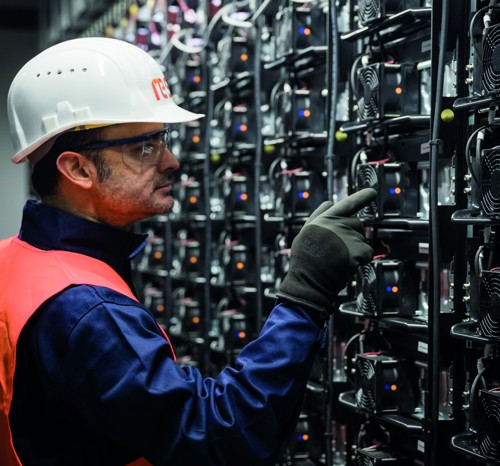
Image for illustrative purposes only
About RES
RES is the world’s largest independent renewable energy company.
RES has been at the forefront of renewable energy development for over 40 years and delivered more than 24GW of renewable energy projects worldwide.
We employ more than 4,500 passionate people across the globe and are active in 24 countries, working across onshore and offshore wind, solar, energy storage, green hydrogen, transmission and distribution.
Sustainability lies at the core of our business activity and values, and we have been leading efforts to create a future where everyone has
access to affordable zero carbon energy.
By listening, discussing, and working together, we can build clean energy project proposals that power positive change for everyone. Find out more at res-group.com
RES in Devon and Cornwall
RES is a significant employer in the south-west, employing over 40 staff in Devon and Cornwall working across development, construction and operations.
As well as its office in Truro, RES has a base in Exeter to directly support the operations and maintenance activities for the solar projects it manages across the UK.
RES is proud to support local jobs and investment in the south-west.
.
RES has developed over 100MW of wind, solar and energy storage projects across Devon and Cornwall, including the development and construction of one of Cornwall’s first wind farms, Carland Cross near Newquay.
RES provide full scope asset management services on over 150MW of renewable assets across Devon and Cornwall including the Den Brook Wind Farm near North Tawton and Batsworthy Cross Wind Farm near South Molton.


